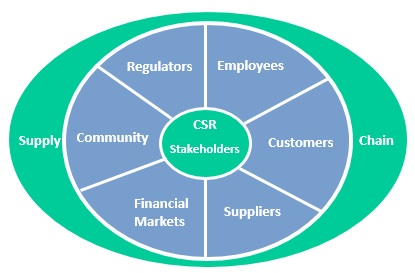Part 2 – Stakeholder based sustainability
Procurement Capabilities in CSR: Stakeholder based sustainability
Procurement Capabilities in CSR: Stakeholder based sustainability – A three part guide for CEO’s, CFO’s and CPO’s to assess how procurement can make CSR a competitive weapon in their organisations success
In Part 1 we discussed protecting corporate reputation. Here in part 2 we discuss a how a stakeholder based approach to sustainability can support a companies brand and reputation
Stakeholders:
Corporations are accountable to a wide range of stakeholders (Fig 1), some formal and some informal. This translates into a commitment for companies to behave in a sustainable manner with both primary and secondary stakeholders and they make stakeholder engagement the foundation of their CSR programmes.
Stakeholders act based on feelings. To create positive feelings organizations have to be relevant to their stakeholders and engage with them on issues they care about. For the smartest corporations, their values drives sustainability deep into their DNA. For these companies CSR is not an overhead, it is part of their value proposition- their identity (what they stand for).
Build a reputation platform:
Leaders align their identity, communications (what a company says), and actions (what a company does). This process is designed to build and reinforce trusting relationships between them and their stakeholders.
By engaging with stakeholders in ways that are relevant to them, the company enhances both brand and reputation.
In order to manage reputation, it is important to have a clear understanding of both perception and reality. By considering reputation in terms of stakeholder perceptions it is possible to manage reputation and build a reputation platform:
- Who are your stakeholders?
- What are they saying about your company?
- Which issues are most important to them?
- What are your reputation risks?
- What are you communicating?
- What is the media writing about?
- How can you be more relevant to your stakeholders?
A reputation platform brings CSR to life by framing and defining the CSR activities you will focus on in your sustainable procurement (SP) strategy, and allow you to leverage the SP drivers of your reputation through actions and communications that will make your SP relevant to your stakeholders.
Given that today, companies source between 40 – 80% of their needs externally with suppliers, they represent the most significant source of CSR risk to most organisations. Other SP stakeholders include, customers and increasingly in leading corporations, with capital markets.
However, few procurement organisations carry out systematic stakeholder engagement.
Through carefully planned engagement, procurement professionals learn about the perceptions and expectations of their stakeholders, and can use this insight to manage and report its key SP issues.
Stakeholder engagement is therefore vital to SP risk management and the protection of corporate reputation.
A systematic stakeholder engagement programme provides benefits ranging from access to the expertise and ideas of stakeholders to integrating a SP culture across the supply chain.
Stakeholder expertise can be fed back into core business strategy and decision making which in turn helps integrate CSR into the DNA of the company rather than being a series of separate initiatives that start and then end.
The challenge with this stakeholder approach is to gain a consensus on how management will behave across the organisation with regard to CSR issues, for example:
- acknowledge stakeholder concerns
- openly communicate with stakeholders
- create policies sensitive to stakeholder concerns
- recognize stakeholder interdependence and fairly distribute benefits
- cooperative with other entities, both public and private
- avoid activities that infringe on human rights
- acknowledge responsibilities to stakeholders and conflicts of interest
A clear process is required (Fig 2), that allows management to develop a communications strategy with the companies stakeholders.
So how can procurement translate a stakeholder approach it into action?
By viewing stakeholders as ‘relationships’ to be managed while developing procurement strategies, procurement can apply many of the principals of SRM to address questions such as:
- What are our stakeholder stakes and influences?
- What opportunities and challenges do our stakeholders present?
- What responsibilities do we have to each stakeholder?
- What strategies or actions should procurement take to deal with stakeholder challenges and opportunities?
The answers to these questions will form the basis of the stakeholder strategy and translate into interactive stakeholder communication, which in turn will lead to a SP strategy aligned around stakeholder demands to:
- Improve procurement practices
- Improve workforce practices
- Improve product/service lifecycle cost
- Reduce logistics cost/impact
It also supports a systematic process to capturing CSR opportunities , managing threats and to demonstrate ‘listening’ rather than ‘telling’.
It is important to avoid self proclaiming statements of good practice and engage in close collaboration with stakeholders on the relevance of what CSR issues to prioritise in your SP strategy. The stakeholder engagement process will also increase organisational awareness regarding stakeholder expectations and identify potentially critical issues of importance for corporate trust and reputation.
In the end it is about trust. A company that has successfully built up close dialogue and trust with its stakeholders, is much more likely to survive the inevitable crisis when it comes.
Nuff said …
In part 3 we discuss a risk based approach



